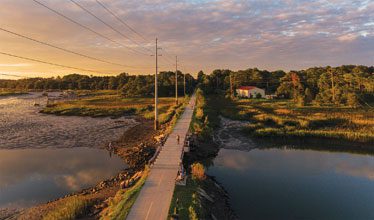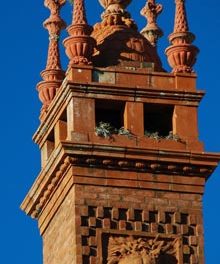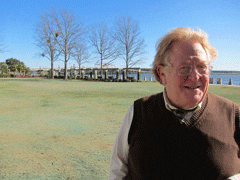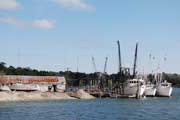 “I can’t think of a single artistic medium we don’t have represented.” Gale Doggette leads me on the nickel tour of the main gallery at the South Carolina Artisans Center, a campus of historic buildings near the heart of downtown Walterboro. This is the official folk art and craft center for the entire state and the collection is truly inspiring. The work of nearly 300 artists is on display and available for purchase. This is a vast and diverse universe of photographers, sculptors, painters, carvers, weavers, and much, much more.
“I can’t think of a single artistic medium we don’t have represented.” Gale Doggette leads me on the nickel tour of the main gallery at the South Carolina Artisans Center, a campus of historic buildings near the heart of downtown Walterboro. This is the official folk art and craft center for the entire state and the collection is truly inspiring. The work of nearly 300 artists is on display and available for purchase. This is a vast and diverse universe of photographers, sculptors, painters, carvers, weavers, and much, much more.
“This is blown glass by Herman C. Leonhardt.” She points out a collection of giant, brightly colored  glass bowls. Often called “the Dale Chihuly of the South,” Leonhardt works out of a studio on the Edisto River, not far from this very space. “We have Lee Sipes’ pine needle baskets,” says Doggette. “Her work’s in the Smithsonian.” It’s easy to see why. The art form is all but forgotten and for a southern boy who’s cursed a pine needle or two when it came time for chores, her work is something of a revelation. I shall curse them less from now on.
glass bowls. Often called “the Dale Chihuly of the South,” Leonhardt works out of a studio on the Edisto River, not far from this very space. “We have Lee Sipes’ pine needle baskets,” says Doggette. “Her work’s in the Smithsonian.” It’s easy to see why. The art form is all but forgotten and for a southern boy who’s cursed a pine needle or two when it came time for chores, her work is something of a revelation. I shall curse them less from now on.
“And these are by Barbara Dengler.” Dengler incorporates smoothly carved wood and intricately woven reed into each of her unique baskets. One of Phillip Greene’s exquisite hand-made mahogany canoes hangs from the ceiling – probably as close to actually floating in water as it will ever get. This one’s a bargain at around $12,000. The former Navy sonar man-turned-artisan will handcraft such a vessel out of ebony for six figures. The center’s Executive Director is quick to point out that the room is literally bursting with original art work for every budget. For instance one of Irving Schulman’s beautiful hand-carved fish is just eight bucks. Sold.
The Interview
 Mark Shaffer: How did this all come together?
Mark Shaffer: How did this all come together?
Gale Doggette: Three local women who realized we needed to do something about the economic development of downtown Walterboro created The Artisans Center. They all shared a love of the arts and had been to other artisans’ centers like Tamarack [West Virginia] and wondered why it couldn’t be done here. With a lot effort, some great initiatives and the backing of Piggly Wiggly they made it happen. And that was sixteen years ago this November.
MS: Not everyone wanted it downtown.
GD: A lot of people wanted it out on the interstate and if we were out there we’d never struggle for money, but that wasn’t the idea. These ladies really wanted people to come in and find out about Walterboro, so they stuck to their guns and here we are.
MS: So instead of going for the easy bucks right off of I-95, the idea was to bring people downtown and use the center as an economic catalyst.
GD: That’s right. The idea is to further the art of South Carolina artisans and also be an economic driver for the town, and it has done so. We have a wonderful relationship with the city and with the downtown merchants. We work real well together recognizing that we can’t market just the Artisans  Center in this economic time, we need to market the whole of Walterboro – the history, antiques, art and nature like the Great Swamp. We all benefit from that.
Center in this economic time, we need to market the whole of Walterboro – the history, antiques, art and nature like the Great Swamp. We all benefit from that.
MS: Is this the largest space of its kind in the state?
GD: I think it is the largest gallery in the state to represent only South Carolina artisans – and they all have to be juried artists. We have 270 plus artisans right now and we’re in the process of putting out the next call for entries. We may very well pass 300.
MS: Once you walk through these doors it’s a little overwhelming. It’s almost hard to describe. There’s so much.
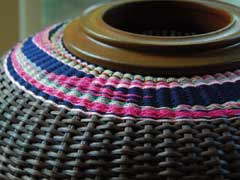 GD: It is hard to describe. I tell people that we have price points from a dollar to twelve thousand dollars. We have the same quality of art you’ll find in very upscale galleries, but we also have the quirky, fun stuff, too. And every piece is an original piece of art. Whatever you buy is one of a kind. We also reserve the right to re-jury if we feel the artisans are not upholding their quality of art. We can request that they be re-juried and have done so in the past.
GD: It is hard to describe. I tell people that we have price points from a dollar to twelve thousand dollars. We have the same quality of art you’ll find in very upscale galleries, but we also have the quirky, fun stuff, too. And every piece is an original piece of art. Whatever you buy is one of a kind. We also reserve the right to re-jury if we feel the artisans are not upholding their quality of art. We can request that they be re-juried and have done so in the past.
MS: How does the jury process work?
GD: We do an annual call for entries and each artist submits five digital photos of their work. In order to avoid any improprieties we always send everything off to three out-of-state art professionals. This year all of them were in North Carolina and they are all artists – a basket weaver, a potter and a painter. We send a criterion to them of five different levels of things like quality and marketability. Once an artist passes a certain level they get to the second stage and physically bring in their work, and we have three other art professionals who judge the work in person.
MS: Never trust a photo in the digital age, right?
GD. Photoshop is a great reason for this second stage. A picture can look absolutely fabulous, but once the jurors get their hands on it they might find flaws that weren’t in the photos. That second  stage is very critical for us.
stage is very critical for us.
MS: It’s all about maintaining a level of quality. This is not a roadside souvenir shop.
GD: No, it is not.
MS: How does the center fit in the grand scheme of things in the revitalization of the downtown economy? In other words, is this a draw for downtown or is downtown a draw for the SCAC, or is it a bit of both?
GD: I think it’s a bit of both. It used to be the Artisans Center that brought everybody in to town – we’ve had billboards on I-95 for years and years. We’ve tracked enough to know that 85 to 90 percent of our clientele come off of 95 and we know that we bring in more than fifteen thousand people annually. We always recommend that they go downtown and that’s a lot of people. If they’ve got the time and they’ve made the commitment to drive the three miles into town they usually do.
MS: What’s another block?
GD: Exactly. It’s like, “Hey, have you seen our downtown? It’s like stepping back into the fifties.” And they just walk over because they don’t even have to move their car, they can just leave it right here, walk over and enjoy the antique stores, specialty shops and restaurants.
MS: There’s that crazy concept of free parking, again (cough, Beaufort, cough).
 GD: Yep, all the free parking you can stand. And in the last few years the downtown merchants and the city of Walterboro have also put up billboards on the interstate to promote shopping and antiques and they’re bringing even more people in. They’re basically doing the same thing downtown that we’re doing over here, saying, “Hey, have you seen the South Carolina Artisans Center?” It’s not unusual for someone to come in and say that so-and-so sent me from Washington Street. It’s a good working partnership and we’re all pleased.
GD: Yep, all the free parking you can stand. And in the last few years the downtown merchants and the city of Walterboro have also put up billboards on the interstate to promote shopping and antiques and they’re bringing even more people in. They’re basically doing the same thing downtown that we’re doing over here, saying, “Hey, have you seen the South Carolina Artisans Center?” It’s not unusual for someone to come in and say that so-and-so sent me from Washington Street. It’s a good working partnership and we’re all pleased.
MS: Even in a tough economy things seem to be going pretty well in downtown Walterboro.
GD: It’s true. Someone recently commented that in other towns people seem to be closing up while in ours they’re opening up. It’s partly due to these tough economic times. It’s so expensive to rent in places like Charleston that merchants have to mark their merchandise up to offset the cost. They come to Walterboro and find wonderful storefront space for less than half of what they were paying there and they can afford to sell for less. The merchant wins and the customer wins. For us here at the Center, we had to focus more on some of the lower priced items – not that we don’t have the higher end items, they’re all over the store. But we have to make sure that when customers come in they can see that anyone can afford to buy art.
MS: And if you really want a $12,000 canoe this is the place to get one.
GD: Oh yeah. And if you really, really, really want to spend money on a canoe you can talk Phillip Greene into building that ebony canoe for $100,000.
MS: Does a $100,000 canoe float better than a $12,000 canoe?
GD: I don’t know, but it sure is pretty.
Find out more online at www.SouthCarolinaArtisansCenter.com or call 843.549.0011

